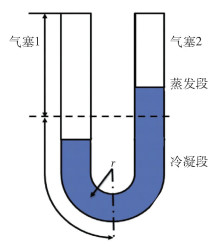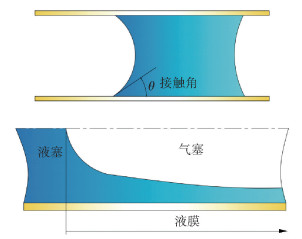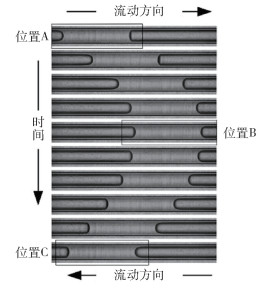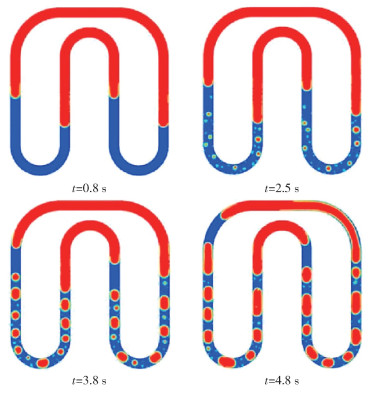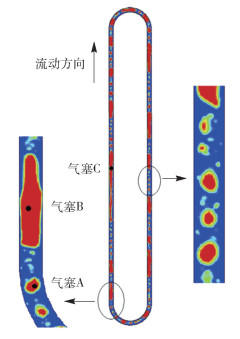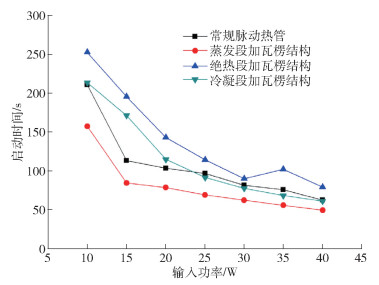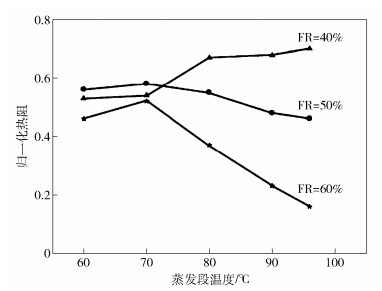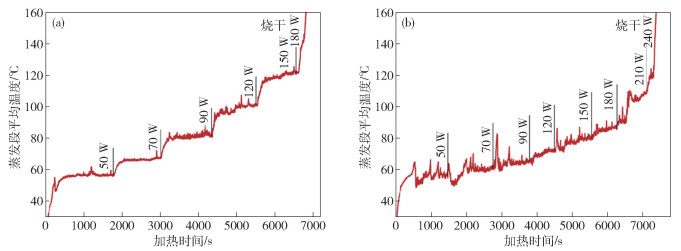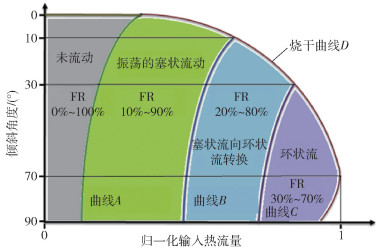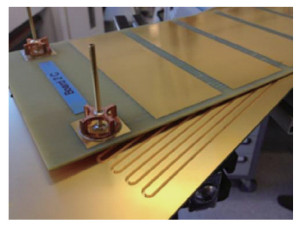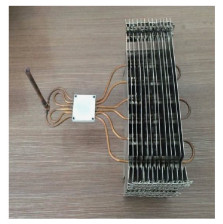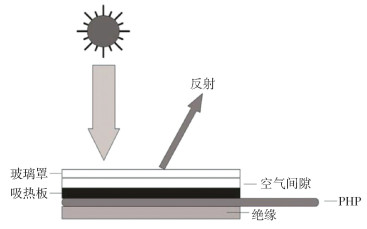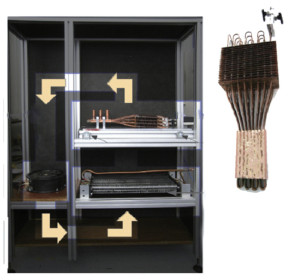-
摘要:
作为一种工作机理独特的新型传热装置,脉动热管具有极高的传热效率、较高的抗烧干能力、良好的环境适应性,且结构简单、可变,成本较低,具有很高的实际应用价值,是目前传热技术领域的研究热点.本文在对脉动热管的优点、结构形式和工作原理进行总体介绍的基础上,首先从理论建模研究入手归纳了目前研究中通常采用的直管、单弯头管、部分单弯头管等结构模型和质量-弹簧-阻尼模型,质量、动量、能量方程模型以及其他数学模型,然后从实验可视化研究和计算可视化研究两方面综述了脉动热管的运行过程、工作机理以及近年来国内外在脉动热管方面的最新研究进展,从启动性能、传热性能和传热极限三方面系统介绍了管径、长度、截面形状、加热方式、充液率、倾斜角度、输入功率和工作流体种类等不同设计和使用参数对脉动热管性能的影响.进一步从设计与应用方面,对脉动热管在电子设备、太阳能集热、动力装置热管理和低温环境换热等方面的研究进行了综述,展示了脉动热管在实际应用中的效果和优势.最后对今后的研究方向与发展趋势进行了展望,指出可通过更详细的理论和仿真建模研究脉动热管的工作机理、工作性能、工作过程和优化设计方法.
Abstract:As a new type of heat transfer device with a unique working mechanism, the pulsating heat pipe (PHP) has high heat transfer efficiency, high resistance capability to drying out, and good environmental adaptability. Its structure is simple and variable, and the cost is low. Thus, the pulsating heat pipe has a good value for practical application and is currently a research hotspot in the field of heat transfer technology. On the basis of the introduction of the general advantages, structure types, and working principle of the pulsating heat pipe, this study first summarized the structure models, such as the straight tube, single elbow tube, and partially single elbow tube, and the theoretical models, such as the mass-spring-damping model, mass-momentum-energy equation model, and other mathematical models, commonly used in the current theoretical modeling research. Then, the operational process, working mechanism, and latest research progress in pulsating heat pipes at home and abroad were reviewed from the aspects of experimental and computational visualization research. The influence of different design and use parameters, such as pipe diameter and length, shape of the section, heating method, filling rate, angle of inclination, input power, and type of working fluid, on the start-up performance, heat transfer performance, and heat transfer limit of the pulsating heat pipe was systematically introduced. Furthermore, from the design and application perspectives, the research on pulsating heat pipes applied in electronic equipment, solar energy collection, thermal management of power unit, and heat exchange in low-temperature environment was reviewed, and the effects and advantages of pulsating heat pipes in practical application were demonstrated. Finally, the future research directions and development trends were forecasted. It is pointed out that the working mechanism, working performance, working process, and optimization design method of pulsating heat pipes can be investigated through a more detailed theoretical and simulation modeling.
-
随着电子半导体技术的进步,小型化和集成化的发展趋势使电子设备单位面积的耗电量和发热量大幅度增加,迫切需要加强高热导率传递装置的研究与应用[1]. 为了适应高热负荷、小空间和低成本的工作和生产要求,发展高效率、被动式的冷却系统是目前研究关注的热点[2]. 而脉动热管是一种新型的传热装置,自从20世纪90年代被发明以来[3],由于其独特的工作原理和优秀的传热性能受到研究者的广泛关注[4].
与传统热管相比,脉动热管有许多突出的优点:
(1) 极高的传热效率. 传统热管的传热效率通常为60%~70%,而脉动热管的最高传热效率可达90%[5];
(2) 较高的抗烧干能力. 脉动热管的烧干现象通常先在单个或几个蒸发管段出现,然后再逐渐扩散到整个蒸发段,因此具有延缓烧干的作用[6];
(3) 良好的适应性. 当热负荷的功率改变时,脉动热管的工作模式也会发生变化. 在一定的范围内,热负荷越大,循环流动性能越好,传热效率越高;
(4) 结构简单、可变,成本较低. 脉动热管通常为长毛细管状,可按工作环境需求弯曲成多种形状;小内径(通常为0.5~3 mm)和无管芯的结构有助于降低制造成本[7].
总的来说,脉动热管的传热效率高、环境适应能力强、占用空间小,结构简单、成本低廉且无污染,具有很高的实际应用价值.
脉动热管的工作原理为:将一段长毛细管道弯曲后分别穿过高温端和低温端形成蒸发段和冷凝段,其余部分为绝热段. 工作前将管内气体抽离至负压状态,然后充入工作流体,在表面张力的作用下形成在管内随机分布的液塞和气塞;工作时,由于蒸发段吸收热量,冷凝段释放热量,导致液塞与气塞的膨胀、压缩和相互转化,并形成液塞振荡运动的驱动力,将热量不断从蒸发段传导至冷凝段. 工作过程中涉及到液膜的蒸发和冷凝、工作流体同管壁接触角的动态变化、气泡的生长和结合以及核态沸腾等现象. 虽然脉动热管结构简单,但是管内热量和质量传递过程中涉及的流体动力学与热力学的耦合使其工作机理非常复杂,很难通过单一的研究方法完整揭示[8-9].
正是由于脉动热管的上述特点,其工作机理和传热性能一直都是研究者关注的重点. 近年来有关脉动热管的研究进展可以大致分为理论建模研究、可视化分析研究、性能影响因素研究和设计与应用研究等几方面.
1. 理论建模研究
按照结构形式,脉动热管可分为开放回路式、闭合回路式和带单向阀的闭合回路式几种(图 1). 脉动热管的理论建模研究主要集中在工作过程的理论建模以及内部动力学特性和传热过程的分析方面. 为了简化建模过程,通常仅研究单弯头管或部分单弯头管,有时还简化为直管. 所采用的理论模型主要有质量-弹簧-阻尼模型,质量、动量、能量方程模型以及其他模型等.
Cheng与Ma[10]将脉动热管简化为直管,假定管内为一维流动,气、液塞相间分布在管道中,通过理想气体状态方程和热力学第一定律建立了气塞的能量守恒方程和液塞的动量方程,汇总后得到液塞和气塞的质量-弹簧-阻尼模型. 通过推导得到液塞的运行速度由蒸发段与冷凝段的温差决定,而固有振动频率随着液塞和气塞在管内的分布状态发生变化. Gürsel等[11]在质量-弹簧-阻尼模型中进一步考虑了表面张力的影响,并通过实验对模型进行了验证.
Kim等[12]将脉动热管简化为U型管道,管道上部为冷凝段,下部为蒸发段,气相位于管道的两端(图 2). 通过牛顿第二定律建立液塞的动量方程以及气塞的能量和质量变化方程. 通过计算发现,初始状态时的工质分布和重力都是影响液塞振荡频率的重要因素. Dilawar与Pattamatta[13]在此基础上运用显示差分格式求解质量、动量和能量方程,计算发现表面张力对工作流体的初始分布具有显著影响.
Li等[14]假设单弯头脉动热管内部只有一个液塞和气塞,通过相变吸热方程和理想气体状态方程推导得到了如式(1)所示的脉动热管启动需要吸收的热量Q. 通过式(1)可以发现,随着充液率的提高,启动所需的热量逐渐上升但存在极值;而倾斜角度对启动热量的影响正好相反. Chiang等[15]建立了多弯头脉动热管的液塞-气塞动力学模型,研究了脉动热管中液塞的位置随时间的变化情况. 通过分析发现,当弯头数较少、充液率较低、工作温度较高、蒸发段与冷凝段的温差较大时,液塞具有更强的振荡动力.
$$ \begin{array}{l} Q = \\ \frac{{\left\{ {2\varepsilon \left( {\cos {\alpha _2} - \cos {\alpha _1}} \right) + r\left[ {\left( {{\rho _{\rm{L}}} - {\rho _{\rm{V}}}} \right)g\left( {{s_2} - {s_1}} \right)\cos \beta - R{\rho _{{\rm{V0}}}}\Delta T} \right]} \right\}{V_{\rm{V}}}{h_{{\rm{LV}}}}}}{{R{T_0}rt}} \end{array} $$ (1) 式中:ε为气液界面的表面张力,N;α为液塞与管壁接触角,rad;r为管内半径,m;ρ为密度,kg·m-3;g为重力加速度,m·s-2;s为高度,m;β为倾斜角度,rad;R为气体常数;ΔT为蒸发段与冷凝段的温度差,K;V为体积,m3;hLV为液相向气相转变时的相变潜热,J·kg-1;t为加热时间,s. 下标L、V分别表示液塞和气塞,0表示参考值,1、2分别表示液塞左端和右端.
综上所述,目前所建立的理论模型可以从一定程度上解释脉动热管的工作机理并分析某些因素对性能的影响规律,但各种理论模型均对脉动热管的结构、管内工质的状态和运行过程进行了一定的简化和假设,很难对脉动热管的实际运行过程进行精确完整的描述.
2. 可视化分析研究
脉动热管的运行机理较为复杂,仅通过理论建模的方法难以完整揭示,而可视化分析可以定性观察脉动热管的启动和运行过程,是理论建模研究的有益补充. 根据研究手段的不同,这方面的研究又可分为实验可视化研究和计算可视化研究两方面. 实验可视化研究是通过在玻璃管内充入工作流体的方式直接观察管内介质的运行现象和规律;而计算可视化研究则是借助仿真分析软件,根据结构参数建立模型,模拟脉动热管的运行过程. 早期的可视化研究主要以实验为主,随着计算流体力学,尤其是多相流理论和流体体积(VOF)方法的发展以及计算机处理能力的提高,计算可视化研究受到了越来越多的关注.
2.1 实验可视化研究
当脉动热管内刚充入工作液体时,在表面张力的作用下,大部分液体以长液柱的形式沉在管道底部,少部分分离成气塞和液塞,相间分布在管内[16]. 分离的液塞与管壁间形成接触角,气塞与管壁间生成液膜[17],如图 3所示.
随着加热功率的增加,当蒸发段的温度达到相变点时,液体会吸热蒸发产生气泡,不断生长和结合的气泡受到管道截面的空间限制向两侧膨胀将长液柱截断,从而形成新的气塞和液塞[18]. 由于液塞下部的气塞不断有气泡汇入使其压力增加,从而在液塞两端的气塞间产生压力差,推动液塞向冷凝段移动[19]. 工质移动过程中与管壁换热使气塞的内部压力下降,造成运动速度下降;然后又通过吸收蒸发段传来的热量,为下次运动积攒能量,从而导致管内的液塞上、下往复移动,工质处于振荡状态(图 4中液塞随着时间的增加从位置A运动到位置B又运动到位置C)[20]. 脉动热管为循环管路,每个平行管道内的液塞都被推向冷凝段并相互挤压;由于各个管段的受热和散热情况不完全一致,这种相互挤压的状态最终被打破,形成工质在管内持续振荡的单向循环流动状态.
随着功率的进一步增加,运动所需的能量能够更快速的补充,液塞的振荡状态逐渐消失,工质处于循环流动状态. 当功率到达一定值时,气泡在蒸发段急速生成,造成蒸发段与冷凝段的压力差变大,冷凝介质不能及时返回蒸发段,导致蒸发段完全被气体占据,工质以塞状流(靠近冷凝段)和环状流(靠近蒸发段)并存的半环状流形式存在;随着加热功率的增加,塞状流和环状流的平衡位置逐渐向冷凝段移动,最终导致环状流占据整个脉动热管,即工质烧干[21]. 因此文献中一般将脉动热管中工质的存在形式分为塞状流、半环状流、环状流和烧干等几类[22]. 在上述过程中,液塞由于蒸发作用会越来越小,而液塞两端的气塞逐渐融合在一起形成长短不一的气塞,最终管内融合为一个气塞,气塞与管壁之间通过液膜传热;工质运动状态的转移过程可以分为:未振荡状态—间歇振荡状态—持续振荡单向循环状态—循环流动状态—烧干状态.
工质运动状态的转变会使脉动热管表面的温度呈现出不同的变化规律,从而使管壁温度成为辨识脉动热管内工质运动状态的重要依据[23],通过管壁的温度可以定性的分析管内的流动状态和潜在的热行为[24]. 同时在工质形式和运动状态的转变过程中,也会出现一些特定的现象,如蒸发段的核态沸腾[25]和气塞间的液桥[26]等.
2.2 计算可视化研究
计算可视化研究是基于计算流体力学中的两相流理论和VOF(volume of fluid)方法进行的. VOF方法将流体分为多个分析域并在各分析域上定义气、液两相的体积分数λ,各分析域的密度ρ、导热系数k与动力黏度μ可以通过如式(2)中所示的单纯气相和液相的密度、单纯气相和液相的导热系数、单纯气相和液相的动力黏度分别与体积分数的乘积得到. 将以上参数代入控制方程并求解,可以得到气、液两相的体积分数随时间变化的函数,并根据该函数跟踪气、液界面的移动情况和气、液两相工作参数的变化情况[27].
$$ \left\{ {\begin{array}{*{20}{c}} {\rho = {\lambda _{\rm{L}}}{\rho _{\rm{L}}} + {\lambda _{\rm{V}}}{\rho _{\rm{V}}}}\\ {k = {\lambda _{\rm{L}}}{k_{\rm{L}}} + {\lambda _{\rm{V}}}{k_{\rm{V}}}}\\ {\mu = {\lambda _{\rm{L}}}{\mu _{\rm{L}}} + {\lambda _{\rm{V}}}{\mu _{\rm{V}}}} \end{array}} \right. $$ (2) 通过仿真计算能够更加清楚的观察到脉动热管在整个运行周期内管内工质存在形式的变化,如气泡的生长、结合以及气塞的断裂过程. Pouryoussefi与Zhang[28-30]通过建立脉动热管的三维计算流体动力学(CFD)模型仿真计算了管内工质在一定的加热功率下,工作状态从启动到稳定运行过程中的变化情况,如图 5所示. 随着时间的增加,气泡首先在蒸发段出现,并最终形成循环的塞状流模式. 在整个过程中,蒸发段的气泡逐渐生长、结合,而冷凝段的气塞则发生了断裂. Wang等[31]也在仿真计算中观察到了气塞的产生和合并过程. 如图 6所示,在A气泡附近首先出现了核态沸腾现象,气泡沿着运动方向逐渐生长、汇集成气塞B,然后形成更大的气塞C.
通过参数化建模和导入用户自定义函数可以方便的改变结构参数和工质的物性参数,从而分析这些参数对脉动热管性能的影响. E等[32-33]在仿真计算过程中观察了工质的流动状态和气塞的合并过程,并与实验结果进行了对比,二者具有良好的一致性. 研究发现管内高压区总是出现在蒸发段,低压区总是出现在冷凝段,且两端压力差越小、绝热段管径越小,气塞与液塞的分布越均匀,脉动热管的传热效率越高,且越容易达到循环流动状态. 唐恺与陈曦[34]通过仿真计算发现,管内工质的物性参数随温度和压力的变化会影响气、液塞的长度及其在管内的分布;同时由于气体的密度和动力黏度远小于液体,在具有较多气体的上升管段内,工质的移动速度要比具有较多液体的下降管段大.
综上所述,脉动热管内的工质具有复杂的运动和存在形式,在不同工况下还会相互转化,通过可视化实验可以清晰准确的观察到工质在整个工作周期内的运动、存在形式和转化过程;借助计算流体力学和热力学分析工具,目前已经可以对脉动热管的工作过程进行较为精确的仿真,但仿真计算工作主要集中在启动和振荡循环过程阶段.
3. 性能影响因素研究
脉动热管的主要性能包括启动性能、传热性能和传热极限等. 而管径、长度、截面形状、加热方式、充液率、倾斜角度、输入功率和工作流体种类等参数均可以对上述性能指标产生影响. 通过深入研究这些因素对脉动热管性能的影响规律,可以进一步提高脉动热管的工作性能,充分发挥其应用潜力.
3.1 启动性能
脉动热管的启动性能主要以启动所需时间的长短、启动所需的最低热流量(或启动所需的输入功率)和启动完成时的温度为基本指标. 启动所需时间越短、启动所需的最低热流量越少、启动完成时的温度越低,启动性能越好. 当脉动热管的温度曲线由不断上升转变为持续振荡状态时,标志着启动完成[35].
脉动热管的结构设计和使用工况会对启动性能产生很大影响. Lin等[36]通过实验研究了不同内径和总长度的脉动热管在水平和垂直状态下的启动性能,发现随着内径的增加和总长度的减小,启动所需的时间和启动所需的输入功率逐渐降低. 在垂直加热条件下的脉动热管更容易启动. Wang等[37]分别在脉动热管的蒸发段、绝热段和冷凝段加入瓦楞结构,在不同输入功率下测试得到了启动所需时间(图 7). 结果表明脉动热管的启动时间随着输入功率的增加而减少;位于蒸发段上的瓦楞结构增加了传热接触面积,因此启动性能最好. Riehl与dos Santos[38]研究了加热位置对脉动热管启动性能的影响,发现顶部加热和底部加热所需的启动功率和启动时间相同,但采用底部加热的启动温度比顶部加热低10 ℃,且启动完成后的温度更加平稳. Thompson等[39]通过实验发现在相同的输入功率下,增加加热面积可以有效减少脉动热管对倾斜角度的敏感性,且小倾斜角度下的启动性能也更好.
脉动热管中工质的变化也会改变其启动性能. Verma等[40]通过实验研究了工作液体的种类和充液率对脉动热管启动性能的影响. 结果表明当去离子水充液率为50%,甲醇充液率为40%时,启动所需的输入功率最小;在最佳充液率下,甲醇的启动速度更快,启动完成时的温度也更低. 王宇与李惟毅[41]通过实验研究了单环路脉动热管在不同充液率下的启动性能,发现在50%及70%的充液率下脉动热管能够顺利启动;而当充液率较低时(30%),需要施加局部热扰动才能启动.
除了上述因素外,工作介质的相变点[42]、相变潜热[43]和表面张力[44]的变化也会对脉动热管的启动性能造成影响. 以纳米流体作为工质的脉动热管[45-46]也是近几年研究的热点之一.
3.2 传热性能
传热性能可以用脉动热管在相同的热流量输入下传输的热量来衡量. 传热效率和热阻是传热性能的常用评价指标,其中传热效率是输出热流量与输入热流量之比,传热效率越高,脉动热管的传热性能越好;热阻是蒸发段和冷凝段的温差与输入热流量之比,热阻越小,管内滞留的热量越少,脉动热管的传热性能越好.
充液率对于脉动热管的传热性能具有显著影响. 当充液率在理想范围内时,脉动热管的传热性能最好;充液率过低时,管内气体较多,可供蒸发的液体较少,极易出现烧干现象;充液率过高时,管内液体较多,导致驱动力较小,工质不易达到循环流动状态. Park等[47]研究了充液率对脉动热管热阻的影响,结果表明当充液率(FR)为60%时,产生的液塞最多,从蒸发段带到冷凝段的热量也最多,热阻最小,如图 8所示. Shi与Pan[48]通过实验发现充液率范围在35%~70%时,脉动热管的热阻较小. 当充液率低于10%时,脉动热管无法启动;随着加热功率的增加,最佳充液率也随之变化.
改变通道的截面形状可以降低脉动热管的热阻,提高传热性能[49]. Tseng等[50]将二分之一的绝热段管路改为椭圆形截面并进行了实验测试,结果表明与圆形截面、均一管径的脉动热管相比,具有椭圆形截面的管路能够产生额外的不平衡压力分布,使工作流体更容易循环运动,因此热阻更小,传热效率更高. 李孝军等[51]将截面改为当量直径为2.82 mm的梯形微槽道(图 9),发现微槽道的毛细作用有利于冷凝液体向蒸发段的回流,其热阻比3.4、4.0和4.8 mm的圆形截面脉动热管分别下降了41.7%、35.6%和30.9%. Xu等[27]通过在圆形截面的蒸发段管内嵌入矩形细槽降低了脉动热管在高输入功率下的热阻.
除了截面形状以外,还有一些结构设计和使用因素也会影响其传热性能. Pastukhov与Maydanik[52]通过试验发现带单向阀的脉动热管更容易实现定向循环流动,传热效率也更高. Aboutalebi等[53]将脉动热管固定在离心机上,通过施加角速度模拟重力场,发现脉动热管旋转产生的离心力使介质更容易返回蒸发段,从而降低了热阻. 管壁的亲水性也会对脉动热管的传热性能产生影响[54-55].
采用纳米流体作为工质也有助于提高脉动热管的传热性能. Mohammadi等[56]通过改变磁性纳米流体的浓度和磁场的安放位置研究了脉动热管传热性能的变化. 实验表明磁性纳米流体可以降低脉动热管的热阻. 当进一步施加磁场时,热阻还会随着磁场安放位置的不同而发生变化. Taslimifar等[57]指出,与去离子水相比,低浓度的铁磁纳米流体可以减小脉动热管稳定状态下的热阻,但高浓度的铁磁流体反而会增大热阻.
3.3 传热极限
传热极限是指脉动热管烧干时输入的热流量,热流量越大,传热极限越高. 烧干是由于蒸发段受热温度过高,产生的气体不能及时冷却,液体不能及时回流造成的. 此时蒸发段完全被气体占据,造成气压过高,液体在冷凝段不能回流到蒸发段,导致蒸发段的温度急剧升高,传热效率快速下降. 当开始烧干时,脉动热管即达到传热极限[58]. 由于蒸发段的温度与管内工质的存在形式密切相关,因此可以通过观察蒸发段的温度判断工质的烧干状态[59].
虽然烧干是由于冷凝的液体无法及时补充至蒸发段造成的,但增加冷凝段的长度却无法起到延缓烧干的作用. 这主要是由于当冷凝段较长时,气塞容易冷却融合为液塞,导致管内气相工质较少而液相工质较多,造成循环流动的动力不足,因此液塞难以快速返回至蒸发段,更容易引起烧干现象的发生[60].
纳米流体不仅可以提高脉动热管的启动性能和传热性能,也可以提高其抗烧干能力. Karthikeyan等[61]通过实验对比了去离子水与纳米流体的传热极限,发现当加热功率达到180 W时,去离子水完全烧干,温度急剧上升;而纳米粒子则增加了工质的导热性和核态沸腾点,有助于热量的快速消散,直至加热功率达到240 W才完全烧干,传热极限增加了33.3%(图 10). 此外,使用混合工质[62]和自湿润流体[63-64]等也可以提高脉动热管的传热极限,延缓烧干现象的出现.
重力可促进冷凝液体的回流,从而延缓烧干现象的出现[65]. Saha等[66]根据实验数据绘制了脉动热管工质的流动状态变化图(图 11),其中横坐标为输入的热流量,纵坐标为倾斜角度,曲线A、B、C为状态转移间隔线,D曲线为烧干极限曲线. 从图中可以看出,当倾斜角度从0°开始增加时,传热极限也逐步增加,直至70°时达到最大,然后又逐渐下降. 在较低或较高的充液率下,烧干都会提前出现,而理想的充液率范围在30%~70%之间.
综上所述,目前在脉动热管的性能影响因素方面已经进行了大量的研究,分析了各种设计和使用参数对脉动热管启动性能、传热性能和传热极限的影响规律,但主要集中在单一因素对单一性能的影响方面.
4. 设计与应用研究
由于脉动热管优秀的传热性和良好的适应性,已经在电子设备、太阳能集热、动力装置热管理等多种领域得到了实际应用. 如图 12所示,Kearney等[67]将板式脉动热管镶嵌在印制电路板(PCB)中,采用非导电性的全氟乙基异丙基酮作为工作流体,通过实验发现其传热效率是铜板的12.5倍,热阻仅为0.2 K·W-1. Dang等[68]为数据中心设计了一套热传递系统,服务器附近的热气体被风扇沿着矩形管道输送到板式脉动热管的蒸发段,再通过脉动热管传递至冷凝段散热,从而将整个数据中心的温度均匀的维持在一定范围内. Lü等[69]将脉动热管应用在功率为100 W的LED灯组上(图 13),可使其维持在70 ℃附近,满足了工作要求. 李志等[70]在相似的应用中发现LED灯组的功率每增加10 W,脉动热管蒸发段的稳定温度平均增加9 ℃,不同功率下蒸发段的温度差可维持在2.5 ℃以内.
Arab等[71]将6弯头脉动热管的蒸发段嵌入到太阳能热水器的集热器里,冷凝段放置在水箱内. 实验发现其能量利用率可达到53.79%,而传统太阳能水热器的能量利用率通常仅为30%左右. Nguyen等[72]在此基础上将弯头数量改为8,发现效率可进一步提升至62%. Kargarsharifabad等[73]在脉动热管的蒸发段上安装了有助于吸收太阳能的黑色集热板(图 14),使其能量利用率提高至66%. Nuntaphan等[74]将脉动热管缠绕在换热器的管道外壁上,使其热交换率提高了10%. 刘建红等[75]将两个脉动热管组合形成了耦合式脉动热管换热器,发现在相同的热源温度下,从蒸发段吸收的热量和冷凝段放出的热量都高于单个脉动热管.
Burban等[76]将脉动热管应用到混合动力汽车的发动机散热器上(图 15),通过台架实验研究了不同工况下的散热性能. 结果表明脉动热管具有较高的稳定性,在不同的发动机温度、倾斜角度和行驶速度下都能正常启动. 员冬玲等[77]在实验中发现,将脉动热管用于发动机散热器时,其散热性能要好于铜质管带式散热器,且风阻更小. Manno等[78]将板式脉动热管应用在纯电动汽车的电池热管理系统中,计算了电池组在不同的输出功率和倾斜角度下的散热性能,结果表明在10~100 W的电芯输出功率下,板式脉动热管能够将电池温度始终维持在工作范围内. Clement与Wang[79]将脉动热管的蒸发段插入燃料电池堆的两极板内,研究了不同输出功率下电池堆表面的温度情况,实验发现当电池堆功率在一定范围内变化时,脉动热管能够维持恒定的温度.
此外,通过在管内充入低临界转换温度的工质,还可以将脉动热管应用在低温环境下,使装置内部的温度保持稳定[80-81].
综上所述,脉动热管具有较高的传热性能和良好的环境适应性,已经在不同的工业领域得到了应用. 由于脉动热管的性能影响因素较多,使用环境又复杂多样,因此需要结合实际应用场合进行脉动热管的设计和优化.
5. 总结与展望
通过以上对近年来脉动热管的最新研究与应用进展情况的回顾可以看出,脉动热管具有优秀的传热性能和复杂的工作机理,并且随着研究工作的不断发展和深入,已逐渐开始在工业生产领域得到应用. 但是还有一些关键技术问题需要进一步研究和解决:
(1) 目前所建立的理论模型对实际结构进行了大量的简化和假设,难以完整分析脉动热管的实际工作过程和各种参数对脉动热管性能的影响;需要建立更加详细的理论模型研究脉动热管的工作机理.
(2) 目前对于脉动热管的仿真计算工作主要集中在启动和振荡循环过程阶段. 随着计算流体力学理论和技术的不断发展和完善,可以对脉动热管的实际工作过程进行更加完整和精确的模拟和分析.
(3) 在当前的性能影响因素研究中,通常仅考虑单一因素的变化对单一性能的影响,其变化也通常是离散的,而在实际结构中,不仅脉动热管的各项性能相互耦合,各参数之间也常常相互耦合并且连续变化,需要更加深入、系统的研究不同因素对脉动热管性能的影响.
(4) 脉动热管的工作原理复杂,影响参数多样,导致其设计难度较大. 随着脉动热管在实际应用中的不断推广,迫切需要研究脉动热管的优化设计方法,并开发专用软件进行脉动热管的辅助设计.
-
-
[1] Fairley J D, Thompson S M, Anderson D. Time-frequency analysis of flat-plate oscillating heat pipes. Int J Therm Sci, 2015, 91: 113 doi: 10.1016/j.ijthermalsci.2015.01.001
[2] Patel V M, Gaurav, Mehta H B. Influence of working fluids on startup mechanism and thermal performance of a closed loop pulsating heat pipe. Appl Therm Eng, 2017, 110: 1568 doi: 10.1016/j.applthermaleng.2016.09.017
[3] Akachi H. Structure of a Heat Pipe: U.S. Patent, 4921041. 1990-5-1
[4] Qu J, Zhao J T, Rao Z H. Experimental investigation on the thermal performance of three-dimensional oscillating heat pipe. Int J Heat Mass Transfer, 2017, 109: 589 doi: 10.1016/j.ijheatmasstransfer.2017.02.040
[5] Leu T S, Wu C H. Experimental studies of surface modified oscillating heat pipes. Heat Mass Transfer, 2017, 53(11): 3329 doi: 10.1007/s00231-017-2051-2
[6] Mameli M, Araneo L, Filippeschi S, et al. Thermal response of a closed loop pulsating heat pipe under a varying gravity force. Int J Therm Sci, 2014, 80: 11 doi: 10.1016/j.ijthermalsci.2014.01.023
[7] Kim J, Kim S J. Experimental investigation on the effect of the condenser length on the thermal performance of a micro pulsating heat pipe. Appl Therm Eng, 2018, 130: 439 doi: 10.1016/j.applthermaleng.2017.11.009
[8] Han X H, Wang X H, Zheng H C, et al. Review of the development of pulsating heat pipe for heat dissipation. Renewable Sustainable Energy Rev, 2016, 59: 692 doi: 10.1016/j.rser.2015.12.350
[9] Nikolayev V S. Effect of tube heat conduction on the single branch pulsating heat pipe start-up. Int J Heat Mass Transfer, 2016, 95: 477 doi: 10.1016/j.ijheatmasstransfer.2015.12.016
[10] Cheng P, Ma H B. A mathematical model of an oscillating heat pipe. Heat Transfer Eng, 2011, 32(11-12): 1037 doi: 10.1080/01457632.2011.556495
[11] Gürsel G, Frijns A J H, Homburg F G A, et al. A mass-spring-damper model of a pulsating heat pipe with a non-uniform and asymmetric filling. Appl Therm Eng, 2015, 91: 80 doi: 10.1016/j.applthermaleng.2015.06.014
[12] Kim S, Zhang Y W, Choi J. Effects of fluctuations of heating and cooling section temperatures on performance of a pulsating heat pipe. Appl Therm Eng, 2013, 58(1-2): 42 doi: 10.1016/j.applthermaleng.2013.03.037
[13] Dilawar M, Pattamatta A. A parametric study of oscillatory two-phase flows in a single turn pulsating heat pipe using a non-isothermal vapor model. Appl Therm Eng, 2013, 51(1-2): 1328 doi: 10.1016/j.applthermaleng.2012.11.025
[14] Li M N, Huang R J, Xu D, et al. Theoretical analysis of start-up power in helium pulsating heat pipe//IOP Conference Series: Materials Science and Engineering, 2017, 171: 012102
[15] Chiang C M, Chien K H, Chen H M, et al. Theoretical study of oscillatory phenomena in a horizontal closed-loop pulsating heat pipe with asymmetrical arrayed minichannel. Int Commun Heat Mass Transfer, 2012, 39(7): 923 doi: 10.1016/j.icheatmasstransfer.2012.05.019
[16] 陈娅琪, 吴慧英. 微型振荡热管非典型振荡的实验研究. 工程热物理学报, 2013, 34(9): 1727 https://www.cnki.com.cn/Article/CJFDTOTAL-GCRB201309030.htm Chen Y Q, Wu H Y. Experimental investigation on an atypical oscillation in silicon-based micro-pulsating heat pipes. J Eng Thermophys, 2013, 34(9): 1727 https://www.cnki.com.cn/Article/CJFDTOTAL-GCRB201309030.htm
[17] Mameli M, Marengo M, Khandekar S. Local heat transfer measurement and thermo-fluid characterization of a pulsating heat pipe. Int J Therm Sci, 2014, 75: 140 doi: 10.1016/j.ijthermalsci.2013.07.025
[18] 胡伟男, 周春鹏, 崔付龙, 等. 单环路平板脉动热管定向循环的数值研究. 低温与超导, 2017, 45(2): 27 https://www.cnki.com.cn/Article/CJFDTOTAL-DWYC201702007.htm Hu W N, Zhou C P, Cui F L, et al. Numerical simulation of a single-loop flat plate pulsating heat pipe under unidirectional flow condition. Cryo Supercond, 2017, 45(2): 27 https://www.cnki.com.cn/Article/CJFDTOTAL-DWYC201702007.htm
[19] 王亚雄, 丁祥云. 新型三维脉动热管的性能. 化工进展, 2016, 35(8): 2367 https://www.cnki.com.cn/Article/CJFDTOTAL-HGJZ201608010.htm Wang Y X, Ding X Y. Performance study for new type of three-dimensional pulsating heat pipe. Chem Ind Eng Prog, 2016, 35(8): 2367 https://www.cnki.com.cn/Article/CJFDTOTAL-HGJZ201608010.htm
[20] Lips S, Bensalem A, Bertin Y, et al. Experimental evidences of distinct heat transfer regimes in pulsating heat pipes (PHP). Appl Therm Eng, 2010, 30(8-9): 900 doi: 10.1016/j.applthermaleng.2009.12.020
[21] 史维秀, 李惟毅, 潘利生. 多通路并联回路板式脉动热管可视化及启动性能试验研究. 机械工程学报, 2014, 50(4): 155 https://www.cnki.com.cn/Article/CJFDTOTAL-JXXB201404025.htm She W X, Li W Y, Pan L S. Experiment study on visualization and start-up performance of closed loop plate pulsating heat pipe with parallel channels. J Mech Eng, 2014, 50(4): 155 https://www.cnki.com.cn/Article/CJFDTOTAL-JXXB201404025.htm
[22] Karthikeyan V K, Ramachandran K, Pillai B C, et al. Understanding thermo-fluidic characteristics of a glass tube closed loop pulsating heat pipe: flow patterns and fluid oscillations. Heat Mass Transfer, 2015, 51(12): 1669 doi: 10.1007/s00231-015-1525-3
[23] 刘向东, 王超, 陈永平. 基于红外热成像的脉动热管运行及传热特性分析. 化工学报, 2016, 67(4): 1129 https://www.cnki.com.cn/Article/CJFDTOTAL-HGSZ201604007.htm Liu X D, Wang C, Chen Y P. Analysis of operation and heat transfer characteristics in pulsating heat pipe based on infrared thermal imaging technology. CIESC J, 2016, 67(4): 1129 https://www.cnki.com.cn/Article/CJFDTOTAL-HGSZ201604007.htm
[24] Karthikeyan V K, Khandekar S, Pillai B C, et al. Infrared thermography of a pulsating heat pipe: Flow regimes and multiple steady states. Appl Therm Eng, 2014, 62(2): 470 doi: 10.1016/j.applthermaleng.2013.09.041
[25] Qu J, Wu H Y, Cheng P. Start-up, heat transfer and flow characteristics of silicon-based micro pulsating heat pipes. Int J Heat Mass Transfer, 2012, 55(21-22): 6109 doi: 10.1016/j.ijheatmasstransfer.2012.06.024
[26] Qu J, Wu H Y. Flow visualization of silicon-based micro pulsating heat pipes. Sci China Technol Sci, 2010, 53(4): 984 doi: 10.1007/s11431-009-0391-y
[27] Xu D H, Chen T F, Xuan Y M. Thermo-hydrodynamics analysis of vapor-liquid two-phase flow in the flat-plate pulsating heat pipe. Int Commun Heat Mass Transfer, 2012, 39(4): 504 doi: 10.1016/j.icheatmasstransfer.2012.02.002
[28] Pouryoussefi S M, Zhang Y W. Nonlinear analysis of chaotic flow in a three-dimensional closed-loop pulsating heat pipe. J Heat Transfer, 2016, 138(12): 122003 doi: 10.1115/1.4034065
[29] Pouryoussefi S M, Zhang Y W. Numerical investigation of chaotic flow in a 2D closed-loop pulsating heat pipe. Appl Therm Eng, 2016, 98: 617 doi: 10.1016/j.applthermaleng.2015.12.097
[30] Pouryoussefi S M, Zhang Y W. Analysis of chaotic flow in a 2D multi-turn closed-loop pulsating heat pipe. Appl Therm Eng, 2017, 126: 1069 doi: 10.1016/j.applthermaleng.2017.01.097
[31] Wang J S, Ma H, Zhu Q. Effects of the evaporator and condenser length on the performance of pulsating heat pipes. Appl Therm Eng, 2015, 91: 1018 doi: 10.1016/j.applthermaleng.2015.08.106
[32] E J Q, Zhao X H, Deng Y W, et al. Pressure distribution and flow characteristics of closed oscillating heat pipe during the starting process at different vacuum degrees. Appl Therm Eng, 2016, 93: 166 doi: 10.1016/j.applthermaleng.2015.09.060
[33] E J Q, Zhao X H, Liu H L, et al. Field synergy analysis for enhancing heat transfer capability of a novel narrow-tube closed oscillating heat pipe. Appl Energy, 2016, 175: 218 doi: 10.1016/j.apenergy.2016.05.028
[34] 唐恺, 陈曦. 低温脉动热管气液两相流数值模拟. 能源工程, 2015(4): 4 doi: 10.3969/j.issn.1004-3950.2015.04.002 Tang K, Chen X. Numerical simulation of vapor-liquid two-phase flow in a cryogenic pulsating heat pipe. Energy Eng, 2015(4): 4 doi: 10.3969/j.issn.1004-3950.2015.04.002
[35] Hu C F, Jia L. Experimental study on the start up performance of flat plate pulsating heat pipe. J Therm Sci, 2011, 20(2): 150 doi: 10.1007/s11630-011-0450-0
[36] Lin Z R, Wang S F, Chen J J, et al. Experimental study on effective range of miniature oscillating heat pipes. Appl Therm Eng, 2011, 31(5): 880 doi: 10.1016/j.applthermaleng.2010.11.009
[37] Wang J S, Ma H, Zhu Q, et al. Numerical and experimental investigation of pulsating heat pipes with corrugated configuration. Appl Therm Eng, 2016, 102: 158 doi: 10.1016/j.applthermaleng.2016.03.163
[38] Riehl R R, dos Santos N. Water-copper nanofluid application in an open loop pulsating heat pipe. Appl Therm Eng, 2012, 42: 6 doi: 10.1016/j.applthermaleng.2011.01.017
[39] Thompson S M, Cheng P, Ma H B. An experimental investigation of a three-dimensional flat-plate oscillating heat pipe with staggered microchannels. Int J Heat Mass Transfer, 2011, 54(17-18): 3951 doi: 10.1016/j.ijheatmasstransfer.2011.04.030
[40] Verma B, Yadav V L, Srivastava K K. Experimental studies on thermal performance of a pulsating heat pipe with methanol/DI water. J Electron Cool Therm Control, 2013, 3: 27 doi: 10.4236/jectc.2013.31004
[41] 王宇, 李惟毅. 充液率对单环路脉动热管启动运行的影响. 中国电机工程学报, 2011, 31(17): 79 https://www.cnki.com.cn/Article/CJFDTOTAL-ZGDC201117013.htm Wang Y, Li W Y. Influence of filling ratio on startup and operation of a single loop pulsating heat pipe. Proc CSEE, 2011, 31(17): 79 https://www.cnki.com.cn/Article/CJFDTOTAL-ZGDC201117013.htm
[42] 王迅, 李达, 李云昭. 甲醇水溶液脉动热管的传热特性. 化工进展, 2014, 33(12): 3170 https://www.cnki.com.cn/Article/CJFDTOTAL-HGJZ201412009.htm Wang X, Li D, Li Y Z. Heat transfer characteristics of pulsating heat pipe with aqueous methanol as working fluid. Chem Ind Eng Prog, 2014, 33(12): 3170 https://www.cnki.com.cn/Article/CJFDTOTAL-HGJZ201412009.htm
[43] 梁倩卿, 郝婷婷, 王凯, 等. 离子液体对脉动热管启动与运行的影响. 工程热物理学报, 2016, 37(12): 2680 https://www.cnki.com.cn/Article/CJFDTOTAL-GCRB201612030.htm Liang Q Q, Hao T T, Wang K, et al. Effect of ionic liquid on the startup and operation performance of the pulsating heat pipe. J Eng Thermophys, 2016, 37(12): 2680 https://www.cnki.com.cn/Article/CJFDTOTAL-GCRB201612030.htm
[44] 蔡骥驰, 王瑞祥, 徐荣吉, 等. SDBS对铜-水脉动热管启动及传热性能影响. 化工学报, 2016, 67(5): 1852 https://www.cnki.com.cn/Article/CJFDTOTAL-HGSZ201605029.htm Cai J C, Wang R X, Xu R J, et al. Influence of SDBS on start time and heat transfer performance of pulsating heat pipe. CIESC J, 2016, 67(5): 1852 https://www.cnki.com.cn/Article/CJFDTOTAL-HGSZ201605029.htm
[45] Jia H W, Jia L, Tan Z T. An experimental investigation on heat transfer performance of nanofluid pulsating heat pipe. J Therm Sci, 2013, 22(5): 484 doi: 10.1007/s11630-013-0652-8
[46] Ji Y L, Ma H B, Su F M, et al. Particle size effect on heat transfer performance in an oscillating heat pipe. Exp Therm Fluid Sci, 2011, 35(4): 724 doi: 10.1016/j.expthermflusci.2011.01.007
[47] Park Y h, Tanshen M R, Nine M J, et al. Characterizing pressure fluctuation into single-loop oscillating heat pipe. J Cent South Univ, 2012, 19(9): 2578 doi: 10.1007/s11771-012-1313-x
[48] Shi W X, Pan L S. Influence of filling ratio and working fluid thermal properties on starting up and heat transferring performance of closed loop plate oscillating heat pipe with parallel channels. J Therm Sci, 2017, 26(1): 73 doi: 10.1007/s11630-017-0912-0
[49] 孙芹, 屈健, 袁建平. 等截面和变截面通道硅基微型脉动热管传热特性比较. 化工学报, 2017, 68(5): 1803 https://www.cnki.com.cn/Article/CJFDTOTAL-HGSZ201705008.htm Sun Q, Qu J, Yuan J P. Heat transfer performance comparison of silicon-based micro oscillating heat pipes with and without expanding channels. CIESC J, 2017, 68(5): 1803 https://www.cnki.com.cn/Article/CJFDTOTAL-HGSZ201705008.htm
[50] Tseng C Y, Yang K S, Chien K H, et al. Investigation of the performance of pulsating heat pipe subject to uniform/alternating tube diameters. Exp Therm Fluid Sci, 2014, 54: 85 doi: 10.1016/j.expthermflusci.2014.01.019
[51] 李孝军, 屈健, 韩新月, 等. 微槽道脉动热管的启动及传热特性. 化工学报, 2016, 67(6): 2263 https://www.cnki.com.cn/Article/CJFDTOTAL-HGSZ201606011.htm Li X J, Qu J, Han X Y, et al. Start-up and heat transfer performance of micro-grooved oscillating heat pipe. CIESC J, 2016, 67(6): 2263 https://www.cnki.com.cn/Article/CJFDTOTAL-HGSZ201606011.htm
[52] Pastukhov V G, Maydanik Y F. Development of a pulsating heat pipe with a directional circulation of a working fluid. Appl Therm Eng, 2016, 109: 155 doi: 10.1016/j.applthermaleng.2016.08.076
[53] Aboutalebi M, Moghaddam A M N, Mohammadi N, et al. Experimental investigation on performance of a rotating closed loop pulsating heat pipe. Int Commun Heat Mass Transfer, 2013, 45: 137 doi: 10.1016/j.icheatmasstransfer.2013.04.008
[54] 郝婷婷, 马学虎, 兰忠, 等. 疏水表面对脉动热管性能的影响. 工程热物理学报, 2014, 35(1): 152 https://www.cnki.com.cn/Article/CJFDTOTAL-GCRB201401035.htm Hao T T, Ma X H, Lan Z, et al. Effects of hydrophobic surface on heat transfer performance and oscillating motion for a pulsating heat pipe. J Eng Thermophys, 2014, 35(1): 152 https://www.cnki.com.cn/Article/CJFDTOTAL-GCRB201401035.htm
[55] 郝婷婷, 马学虎, 兰忠, 等. 超亲水脉动热管液弹液膜沉积的实验研究. 工程热物理学报, 2015, 36(1): 168 https://www.cnki.com.cn/Article/CJFDTOTAL-GCRB201501036.htm Hao T T, Ma X H, Lan Z, et al. Experimental investigation of the effect of superhydrophilic surface on the liquid film deposition of a pulsating heat pipe. J Eng Thermophys, 2015, 36(1): 168 https://www.cnki.com.cn/Article/CJFDTOTAL-GCRB201501036.htm
[56] Mohammadi M, Taslimifar M, Haghayegh S, et al. Open-loop pulsating heat pipes charged with magnetic nanofluids: powerful candidates for future electronic coolers. Nanoscale Microscale Thermophys Eng, 2014, 18(1): 18 doi: 10.1080/15567265.2013.787570
[57] Taslimifar M, Mohammadi M, Afshin H, et al. Overall thermal performance of ferrofluidic open loop pulsating heat pipes: an experimental approach. Int J Therm Sci, 2013, 65: 234 doi: 10.1016/j.ijthermalsci.2012.10.016
[58] 王迅, 毛欣欣, 王磊, 等. 脉动热管的传热极限特性. 天津大学学报, 2012, 45(10): 870 https://www.cnki.com.cn/Article/CJFDTOTAL-TJDX201210005.htm Wang X, Mao X X, Wang L, et al. Characteristics of heat transfer limit in pulsating heat pipe. J Tianjin Univ, 2012, 45(10): 870 https://www.cnki.com.cn/Article/CJFDTOTAL-TJDX201210005.htm
[59] Cui X Y, Zhu Y, Li Z H, et al. Combination study of operation characteristics and heat transfer mechanism for pulsating heat pipe. Appl Therm Eng, 2014, 65(1-2): 394 doi: 10.1016/j.applthermaleng.2014.01.030
[60] Wang S F, Chen J J, Hu Y X, et al. Effect of evaporation section and condensation section length on thermal performance of flat plate heat pipe. Appl Therm Eng, 2011, 31(14-15): 2367 doi: 10.1016/j.applthermaleng.2011.03.037
[61] Karthikeyan V K, Ramachandran K, Pillai B C, et al. Effect of nanofluids on thermal performance of closed loop pulsating heat pipe. Exp Therm Fluid Sci, 2014, 54: 171 doi: 10.1016/j.expthermflusci.2014.02.007
[62] Wang W Q, Cui X Y, Zhu Y. Heat transfer performance of a pulsating heat pipe charged with acetone-based mixtures. Heat Mass Transfer, 2017, 53(6): 1983 doi: 10.1007/s00231-016-1958-3
[63] Hu Y X, Liu T Q, Li X Y, et al. Heat transfer enhancement of micro oscillating heat pipes with self-rewetting fluid. Int J Heat Mass Transfer, 2014, 70: 496 doi: 10.1016/j.ijheatmasstransfer.2013.11.031
[64] 张明, 苏新军, 韩魏, 等. 氧化石墨烯/自湿润流体脉动热管的传热特性. 化工进展, 2015, 34(8): 2951 https://www.cnki.com.cn/Article/CJFDTOTAL-HGJZ201508009.htm Zhang M, Su X J, Han W, et al. Heat transfer characteristics of pulsating heat pipe with grapheme oxide/self-rewetting fluid. Chem Ind Eng Prog, 2015, 34(8): 2951 https://www.cnki.com.cn/Article/CJFDTOTAL-HGJZ201508009.htm
[65] 史维秀, 潘利生, 李惟毅. 倾角及冷却工况对多通路并联回路板式脉动热管传热性能的影响. 化工学报, 2014, 65(2): 532 doi: 10.3969/j.issn.0438-1157.2014.02.023 Shi W X, Pan L S, Li W Y. Influences of inclination and cooling condition on heat transfer performance of closed loop plate pulsating heat pipe with parallel channels. CIESC J, 2014, 65(2): 532 doi: 10.3969/j.issn.0438-1157.2014.02.023
[66] Saha N, Das P K, Sharma P K. Influence of process variables on the hydrodynamics and performance of a single loop pulsating heat pipe. Int J Heat Mass Transfer, 2014, 74: 238 doi: 10.1016/j.ijheatmasstransfer.2014.02.067
[67] Kearney D J, Suleman O, Griffin J, et al. Thermal performance of a PCB embedded pulsating heat pipe for power electronics applications. Appl Therm Eng, 2016, 98: 798 doi: 10.1016/j.applthermaleng.2015.11.123
[68] Dang C, Jia L, Lu Q Y. Investigation on thermal design of a rack with the pulsating heat pipe for cooling CPUs. Appl Therm Eng, 2017, 110: 390 doi: 10.1016/j.applthermaleng.2016.08.187
[69] Lü L C, Li J, Zhou G H. A robust pulsating heat pipe cooler for integrated high power LED chips. Heat Mass Transfer, 2017, 53(11): 3305 doi: 10.1007/s00231-017-2050-3
[70] 李志, 贾力, 魏文博. 基于板式脉动热管的LED自然对流冷却实验研究. 工程热物理学报, 2013, 34(7): 1361 https://www.cnki.com.cn/Article/CJFDTOTAL-GCRB201307040.htm Li Z, Jia L, Wei W B. Experimental study on natural convection cooling of LED based on plate pulsating heat pipe. J Eng Thermophys, 2013, 34(7): 1361 https://www.cnki.com.cn/Article/CJFDTOTAL-GCRB201307040.htm
[71] Arab M, Soltanieh M, Shafii M B. Experimental investigation of extra-long pulsating heat pipe application in solar water heaters. Exp Therm Fluid Sci, 2012, 42: 6 doi: 10.1016/j.expthermflusci.2012.03.006
[72] Nguyen K B, Yoon S H, Choi J H. Effect of working-fluid filling ratio and cooling-water flow rate on the performance of solar collector with closed-loop oscillating heat pipe. J Mech Sci Technol, 2012, 26(1): 251 doi: 10.1007/s12206-011-1005-8
[73] Kargarsharifabad H, Mamouri S J, Shafii M B, et al. Experimental investigation of the effect of using closed-loop pulsating heat pipe on the performance of a flat plate solar collector. J Renewable Sustainable Energy, 2013, 5(1): 013106 doi: 10.1063/1.4780996
[74] Nuntaphan A, Vithayasai S, Vorayos N, et al. Use of oscillating heat pipe technique as extended surface in wire-on-tube heat exchanger for heat transfer enhancement. Int Commun Heat Mass Transfer, 2010, 37(3): 287 doi: 10.1016/j.icheatmasstransfer.2009.11.006
[75] 刘建红, 商福民, 刘登瀛. 脉动热管间协同耦合强化传热特性实验分析. 化工学报, 2011, 62(6): 1549 doi: 10.3969/j.issn.0438-1157.2011.06.011 Liu J H, Shang F M, Liu D Y. Enhanced heat transfer characteristics of synergistic coupling between pulsating heat pipes. CIESC J, 2011, 62(6): 1549 doi: 10.3969/j.issn.0438-1157.2011.06.011
[76] Burban G, Ayel V, Alexandre A, et al. Experimental investigation of a pulsating heat pipe for hybrid vehicle applications. Appl Therm Eng, 2013, 50(1): 94 doi: 10.1016/j.applthermaleng.2012.05.037
[77] 员冬玲, 邵敏, 蔡中盼, 等. 振荡流热管汽车散热器传热性能的实验研究. 制冷学报, 2013, 34(5): 77 doi: 10.3969/j.issn.0253-4339.2013.05.077 Yuan D L, Shao M, Cai Z P, et al. Experiment study on heat transfer performance of oscillating heat pipe radiator for automobile. J Refrig, 2013, 34(5): 77 doi: 10.3969/j.issn.0253-4339.2013.05.077
[78] Manno V, Filippeschi S, Mameli M, et al, Thermal-hydraulic characterization of a flat plate pulsating heat pipe for automotive applications. Interfacial Phenom Heat Transfer, 2015, 3(4): 413 doi: 10.1615/InterfacPhenomHeatTransfer.2016013273
[79] Clement J, Wang X. Experimental investigation of pulsating heat pipe performance with regard to fuel cell cooling application. Appl Therm Eng, 2013, 50(1): 268 doi: 10.1016/j.applthermaleng.2012.06.017
[80] Deng H R, Liu Y M, Ma R F, et al. Experimental investigation on a pulsating heat pipe with hydrogen//IOP Conference Series: Materials Science and Engineering, 2015, 101: 012065
[81] Natsume K, Mito T, Yanagi N, et al. Heat transfer performance of cryogenic oscillating heat pipes for effective cooling of superconducting magnets. Cryogenics, 2011, 51(6): 309 doi: 10.1016/j.cryogenics.2010.07.001
-
期刊类型引用(7)
1. 张宇航,吴思远,孙瑜,赵日晶,黄东. 常温闭环脉动热管性能影响因素研究综述. 制冷学报. 2024(05): 47-62 .  百度学术
百度学术
2. 李晓娜,徐荣吉,吴青平,赵远强. 冷却温度对平板脉动热管传热特性影响的试验研究. 流体机械. 2023(02): 1-10 .  百度学术
百度学术
3. 刘建红,刘栋,阎天海,曹欣,巨海娇,商福民. 脉动热管换热器传热性能试验研究. 长春工程学院学报(自然科学版). 2023(04): 69-73 .  百度学术
百度学术
4. 赵佳腾,吴晨辉,戴宇成,饶中浩. 脉动热管强化传热及其应用研究进展. 化工学报. 2022(02): 535-565 .  百度学术
百度学术
5. 陈赵军,孟凡凯,徐辰欣. 热管式两级热电冷水机性能分析与优化. 工程科学学报. 2022(12): 2177-2188 .  本站查看
本站查看
6. 冯艳民,纪玉龙,吴梦珂,杨鑫,李亚东,刘忠浩. 金刚石—钠钾合金高温脉动热管实验研究. 工程热物理学报. 2022(11): 3049-3060 .  百度学术
百度学术
7. 姚孟良,甘云华,梁嘉林,李勇. 电动汽车集成热管理研究进展. 工程科学学报. 2020(04): 412-422 .  本站查看
本站查看
其他类型引用(23)



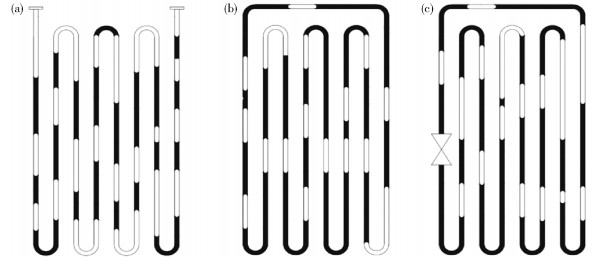
 下载:
下载:
